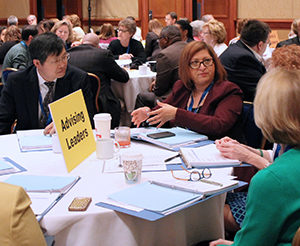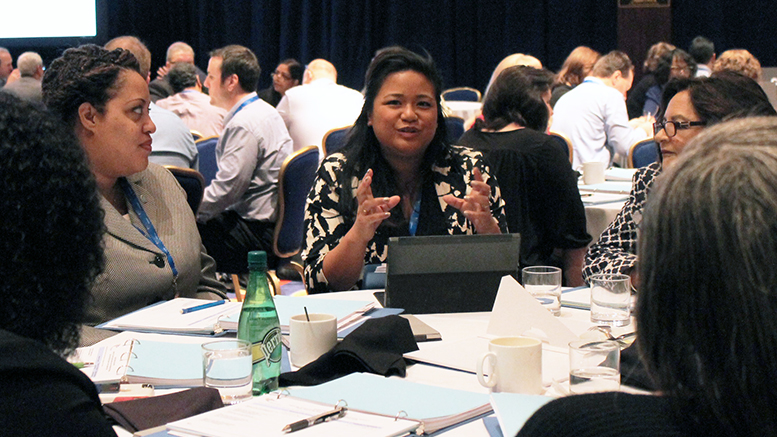As I mingled in the crowd of professors and administrators at my first American Association of Community Colleges (AACC) Pathways Project conference near Houston, Texas, the phrase “Here we go again” crossed my mind.
There has been no shortage of ideas, projects and conferences claiming to solve the various issues facing higher education, such as increasing attendance or retention, improving critical thinking skills or lowering costs.
Faculty who have been around for a decade or more have seen many educational trends come and go, some with a little success and others with none. Many faculty see the “next big thing” as just the “next big pointless thing” that will be replaced in a year or two with another trend. More than a few faculty would say that these trends and projects are just more work and accountability measures conjured up by some think tank or agency that will do little to improve education, simply a hoop to jump through.
I did my best to hold these thoughts at bay and to enter into the conference with an open mind. As I listened to the research behind the Pathways Project, I began to see the logic involved. Imagine if our college really could develop clear, easily followed pathways to the degrees our students sought. Imagine if the programs of study the students entered were crystal clear to all involved and aligned with their future employment or educational goals.
Could we make it clearer, limit choices, schedule two years of courses in advance, and get more intrusive with our advising to help students clarify and achieve their goals? Our college was already doing much of this out of necessity. The initiatives and research into Pathways started making sense to me as I listened and read more about the Bill and Melinda Gates-funded project. As I listened to speaker after speaker, I noticed my head nodding more and more in agreement. I began to get excited and to realize how great it was for my college — Paris Junior College — to be among the 30 selected to be part of this project.
Evolving education
As a science professor at Paris Junior College, I tend to be skeptical of everything. It is in my nature to want to poke holes in new ideas and research. Science has progressed because of this inherent skepticism. The great theories of science exist today because they have withstood the process of science. After all, the theory of evolution is the foundation of the life sciences, not because we love it or because we have been indoctrinated, but because it has withstood the skeptical nature and rigorous testing of science for more than 150 years.
This article comes from the current issue of the Community College Journal, which has been published by the American Association of Community Colleges since 1930.
I mention evolution because within the grand theory is a hypothesis known as the Red Queen Effect. The Red Queen Effect was proposed by evolutionary biologist Leigh Van Valen and states that species must constantly evolve just to remain where they are. It was named the Red Queen after an excerpt from Lewis Carroll’s “Through the Looking Glass.”

As the story goes, Alice is running as fast as she can but notices that she seems to be getting nowhere. Alice asks the Red Queen why this is, and the Red Queen tells her: “Here, you see, it takes all the running you can do, to keep in the same place. If you want to get somewhere else, you must run at least twice as fast as that!”
So, in a co-evolutionary scenario where species are in a dynamic environment and evolving with one another, both must constantly evolve just to stay where they are or face extinction of one or both. Imagine if the fastest cheetahs in the population could run 80 mph and the fastest gazelles in the population only 20 mph: one is a clear loser there. Or, what if species’ immune systems failed to keep pace with rapidly changing parasites?
Now, imagine a world where professors and colleges do not keep up with the changes that occur in student populations over time — a world where course delivery remained the same, advising never changed and student services were frozen in time. Now assume student populations are changing due to changing secondary curricula and culture (and perhaps rapidly). Who do you predict faces extinction? Should colleges take the “if it ain’t broke don’t fix it” approach and expect their very different students to adapt to them and their ways or should they co-evolve? Will the “this is how it has always been done” policy function as a model in the future for professors and colleges?
Avoiding extinction
For us to stay set in our ways, unwilling to change, is a recipe for disaster. As I sat through the Pathways meetings, I began to view their content through an evolutionary lens. Pathways is based in the observations and research gathered in higher education showing that student populations are changing and that the deliverers of education had best change with them or face extinction.

Gone are the days when students showed up to take random courses for a few years before deciding on a degree. Students were wasting too much money and graduating with far more credits and debt than needed. Modern students need and want more direction and degree pathways that are clear, adaptable, easy to follow, and easy to plan around in their often busy lives.
As a result, colleges need to rethink advising, course scheduling and course delivery. Colleges must evolve with the changing student populations.
Read the full article in Community College Journal online.

